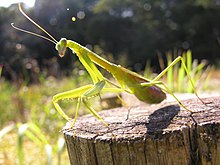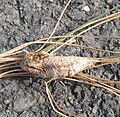Tenodera angustipennis
| Tenodera angustipennis | |
|---|---|

| |
| Adult female Tenodera angustipennis | |
| Scientific classification | |
| Domain: | Eukaryota |
| Kingdom: | Animalia |
| Phylum: | Arthropoda |
| Class: | Insecta |
| Order: | Mantodea |
| Family: | Mantidae |
| Genus: | Tenodera |
| Species: | T. angustipennis
|
| Binomial name | |
| Tenodera angustipennis Saussure, 1869
| |
| Synonyms | |
Tenodera angustipennis is a species of mantis native to Asia and nearby areas of Oceania. The species was introduced and became established in the eastern United States. Tenodera angustipennis was noticed as early as 1921 in Aberdeen, Maryland, but that occurrence was not noted in a published record until 1933.[3][4]
Etymology[edit]
This species has two common names narrow-winged mantis and Japanese mantis in English.[5] This insect is known as チョウセンカマキリ (translates to "Korean mantis") in the Japanese language and 참사마귀, (an alternative name which translates to "true mantis") as well as just plain 사마귀 (a formal name) in the Korean language (사마귀 can mean the whole order of Mantodea or this specific species of praying mantis).
"Tenodera" is from Greek meaning "slender neck" and "angustipennis" is from Latin meaning "narrow wing".[6][7]
Description[edit]
Adults and nymphs[edit]
Size: Males 65~80 mm, females 68~85 mm in length. Tenodera angustipennis are often brown or green. Tenodera angustipennis proportionately have a more elongate pronotum and shorter, narrower tegmina and wings than Tenodera sinensis.[4] T. angustipennis have a brown, patterned streak on each of their transparent hind wings, while T. sinensis have hind wings that are completely patterned and brown.[3][8] [9] The Chinese mantis is thicker or more stocky than the narrow-winged mantis. It can be easy for a person to tell apart between the adults of these two species, Tenodera angustipennis and Tenodera sinensis, when the two species are placed side by side.[4]
Ootheca[edit]
The oothecae of Tenodera angustipennis are elongate,[3] about 40 to 60 millimeters long and about 14 millimeters in diameter[4] and are sometimes mistaken to be Stagmomantis carolina oothecae.[10] T. angustipennis oothecae probably hatch around 1 to 2 weeks later than T. sinensis do.[3]
Range[edit]
This species occurs in China, Hawaii, India,[11] Java, Korean Peninsula,[11][12] Ulleung-do, Jejudo, Taiwan, Vietnam, Honshu, Shikoku, Kyushu, Tsushima Island, Okinawa Island.[13][14]
Non-native range in the United States:
Delaware,[15] Maryland,[16]New York,[3] North Carolina,[8] New Jersey,[4][17] Ohio,[4] Pennsylvania,[4][18]Virginia.[3]
Habitat[edit]
The oothecae are often laid on twigs of shrubs, stems of tall herbs, but in field margins they seem to prefer to lay their oothecae on tree trunks and fence posts.[4] In some areas T. angustipennis is just as common as T. sinensis.[3]
Additional images[edit]
-
Adult female Tenodera angustipennis
-
Adult male Tenodera angustipennis
-
Egg case
See also[edit]
References[edit]
- ^ Matsura, Toshiaki; Morooka, Kiyomi (1983). "Influences of prey density on fecundity in a mantis, Paratenodera angustipennis (S.)". Oecologia. 56 (2–3). Springer-Verlag: 306–312. Bibcode:1983Oecol..56..306M. doi:10.1007/BF00379704. ISSN 0029-8549. PMID 28310208. S2CID 23392302.
- ^ http://mantodea.speciesfile.org/Common/basic/Taxa.aspx?TaxonNameID=1184318 Otte, Daniel, Lauren Spearman and Martin B.D. Stiewe. Mantodea Species File Online. Version 5.0/5.0. Retrieval Date: 2014/6/21. http://Mantodea.SpeciesFile.org Subspecies Tenodera aridifolia angustipennis Saussure, 1869
- ^ a b c d e f g "Annual report of the Board of Regents of the Smithsonian Institution". Smithsonian Institution Board of Regents. 1950: 356. 1965. ISSN 0096-4093.
- ^ a b c d e f g h "Entomological News". 44. Philadelphia American Entomological Society. 1933: 1–5. ISSN 0013-872X.
{{cite journal}}: Cite journal requires|journal=(help) - ^ http://bugguide.net/node/view/214178 Bugguide.net Page: Info: Species Tenodera angustiepennis
- ^ Blatchley, Willis Stanley (1920). Orthoptera of northeastern America: with especial reference to the faunas of Indiana and Florida. The Nature Publishing Company. pp. 122–123.
- ^ http://www.archives.nd.edu/cgi-bin/wordz.pl?keyword=pennis /[1] William Whitaker's Words
- ^ a b http://bugguide.net/node/view/344166 Bugguide.net By Bugguide user Richard Throne. Title: Tenodera angustipennis (narrow winged mantis). Location: Pitt County, North Carolina, USA. Date: September 26, 2009. The person's description about this Bugguide photo: "Note the clear wings and the more pointy shape. This is one way to distinguish this species from Tenodera sinensis."
- ^ http://bugguide.net/node/view/576042 Bugguide.net By Bugguide user ADeczynski. Title: Tenodera angustipennis - Tenodera aridifolia sinensis comparison male. Location: Newark, New Castle County, Delaware, USA.
- ^ http://bugguide.net/node/view/501536/bgimage Bugguide.net: By Bugguide User Link Davis, Title: Ootheca, From: Schwenksville, Montgomery County, Pennsylvania, USA, Date: June 18, 2008
- ^ a b "Archived copy" (PDF). Archived from the original (PDF) on 2013-09-17. Retrieved 2014-02-15.
{{cite web}}: CS1 maint: archived copy as title (link) Title: Updated Checklist of India Mantodea (Insecta) Authors: Mukherjee et al. Date:1995 - ^ http://insects.tamu.edu/research/collection/hallan/Arthropoda/Insects/Mantodea/Family/Mantidae.txt Texas A&M University
- ^ http://konchudb.agr.agr.kyushu-u.ac.jp/dji/exec/d-search3.cgi?g=Tenodera&s=angustipennis
- ^ "チョウセンカマキリ (カマキリ)".
- ^ http://bugguide.net/node/view/576034/bgimage Bugguide.net By Bugguide user ADeczynski. Title: Tenodera angustipennis. Location: Newark, New Castle County, Delaware, USA. Date: September 1, 2011.
- ^ http://bugguide.net/node/view/880800/bgimage Bugguide.net By Bugguide user Benjamin JD. Title: Narrow-winged Mantis. Location: Parkville, Baltimore County, Maryland, USA. Date: September 19, 2013. Description about this Bugguide photo: "Mantis with bright orange spot between front praying legs."
- ^ http://bugguide.net/node/view/67578/bgimage Bugguide.net By Bugguide user Paul Krombholz. Title: Tenodera angustipennis, mating pair. Location: New Jersey, USA. The person's description about this Bugguide photo: "These are lab-reared mantids, but their ancestors were collected in New Jersey, near Princeton University in a field where both T. sinensis and T. angustipennis existed. How do you tell them apart? The differences are subtle. Angustipennis is a bit more slender than sinensis, the green borders of the wings are narrower, The colors are slightly different in both green and brown forms. Sinensis green is a little bluer and sinensis brown is darker and a little more yellow. Angustipennis has an orange spot bordered in black between the forelegs (used in threat display), and sinensis has yellow, instead of orange. The egg cases are very different, that of sinensis being large and puffy, and that of angustipennis being flattened with very little foam material."
- ^ http://bugguide.net/node/view/861831/bgimage Bugguide.net By Bugguide user Bill Keim . Title: Narrow-winged Mantis. Location: Buckingham, Bucks County, Pennsylvania, USA. Date: November 2, 2013.
Bibliography[edit]
- 김정환 (1998). 한국의 잠자리, 메뚜기, 사마귀, 대벌레/THE ODONATA and ORTHOPTERA, ETC. OF KOREA IN COLOR. KYOHAK PUBLISHING CO., LTD. SEOUL, KOREA. p. 431.



